Forget pony-trekking on a wet weekend in Bognor. If you’re serious about learning to ride horses, saddle up with the cowboys in Arizona and really earn your spurs, says Abi Campbell
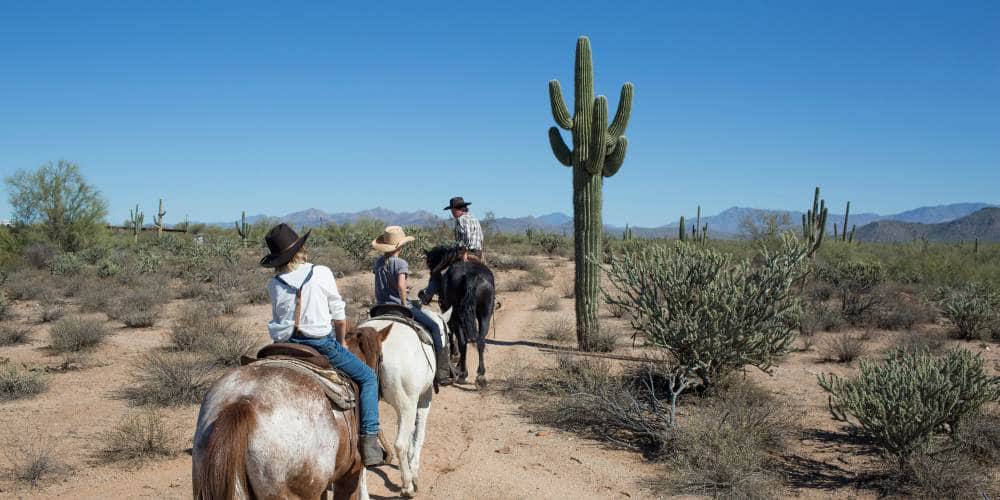
Family horseback adventures at Tanque Verde Ranch
Generation X was weaned on Wild West imagery. On wet weekends, I’d long for some child- friendly TV, but in the 1970s, programming was invariably limited to darts, the Open University and gunslinging Westerns, so I’d opt for the latter. The storylines flew over my head like speeding bullets, but sunny desert landscapes afforded cinematic escapism from cul-de-sac views through my rain-streaked windows, and I’d daydream about becoming a cowgirl.
Thirty-five years on, I’ve come to Arizona to live out my childhood fantasy, to learn to ride Western-style, with kids of my own. I’m not remotely horsey, and never pushed my children to ride, save for a couple of beach hacks on the Isle of Wight.
My relationship with the beast is one of mistrust, having had to hang on for dear life when every horse I ever rode would bolt for the hills, or smugly toss me off their back. My daughter, Jemima, nine, apparently inherited my equestrian misfortune. In her second (and last) lesson, her pony got spooked and faceplanted her dramatically into the dirt. I think it is fair to say we were more excited about seeing cacti than horses.
We didn’t know what to expect from a ‘dude ranch’ (aka a guest ranch for tourists). I imagined we’d be woken at sunrise, served cold grits and be put to task by a stony-faced wrangler.
I had visions of tirelessly mucking out stables and brushing down stallions in the midday sun, retiring at dusk to an airless shack with an awkward cowboy’s gait, chafed, weatherbeaten and exhausted. In hindsight, I was still very much under the influence of Hollywood artistic licence, since the reality couldn’t have been more different – at our first ranch, at least. Guest ranches were conceptualised in the 1950s, when iconic Western movies like The Lone Ranger piqued interest in cowboy culture.
Tanque Verde Ranch was one of the first, and is what I would call a ‘resort ranch’. You can’t please everyone all of the time, and that’s certainly the case when considering an active family holiday. There might be members who aren’t remotely interested in exploring the desert on horseback, but still want the ranch experience. That’s where somewhere like Tanque Verde comes in.
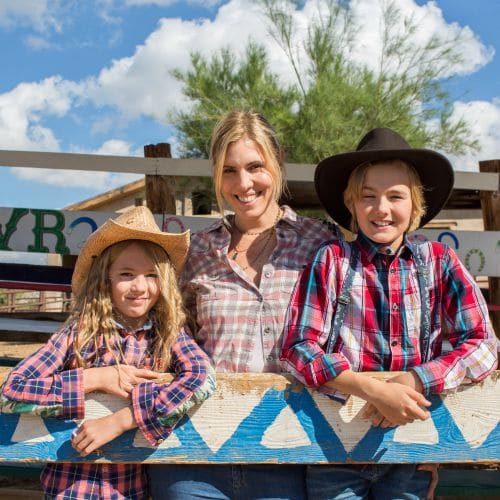
Round ’em up! Momma watches over her charges
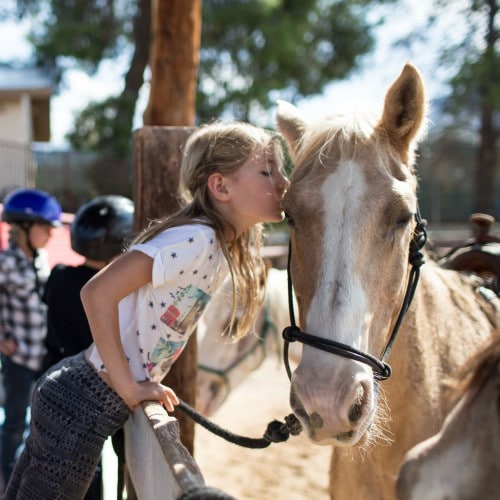
Momma’s little horse whisperer
Located in Tucson, at the foothills of the Rincon Mountains, the ranch offers something for everyone: hiking, mountain-biking, nature programmes, Native American workshops, tennis, yoga, a spa and a pool. For folks champing at the bit to saddle up, riding is the main event, and here, they cater to every age and level of experience. To the chagrin of my children, I cracked the proverbial whip, insisting we fully embrace the equestrian programme.
To blend in with the locals, a visit to The Boot Barn – the cowboy equivalent of M&S – was required. Donning our new checked shirts, cowboy boots and hats, we headed towards the Buckaroo Bunkhouse. Here, the kids’ club runs daily from 6.45am – 3pm: riding lessons in the morning and afternoons in a dedicated arena, followed by trail rides parents can join. The kids bonded with their four-legged friends and mastered control of them surprisingly quickly.
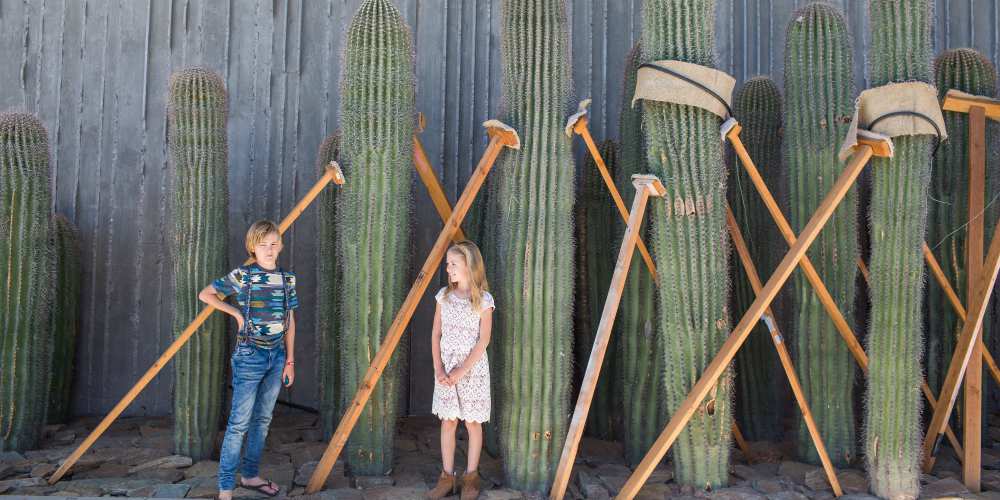
Saguaro cacti (supported by struts) dwarf the children
That said, the horses were clearly so well versed in their daily grind, they may have been riding themselves.The breakfast trail rides were a stratospheric high point, and the rewards of our twilight wake-up calls paid off handsomely. Riding through towering cacti into a blazing amber sunrise to dine at a mountain homestead was one of the coolest things we’ve ever done.
The horses walked slowly, nose to tail, and we mostly sat back and enjoyed the ride. Jemima blubbed only once, when her horse had a snack-attack on a bush, holding up our group (the pressure compounded by her brother yelling,‘Hurry up!’). The wranglers reminded her to let her horse know who was boss, a tall order for a little girl with twiglet arms.
Between rides, the children did crafts, swam, listened to talks on poisonous desert critters, fished and played hard. They were so exhausted at the end of day, they fell asleep in their food. Twice. The dinner worth staying up for was the cook-out in the Cottonwood Grove. This is where Jemima made lifelong friends and Ellis, 11, fell a teensy bit in love with an American girl who lassoed him.
We ate from a mountainous BBQ, entertained by live country music. We played horseshoe-pitching, toasted marshmallows to stuff into s’mores, and line-danced for hours in the soft glow of the festoon lights strung up between trees. Holidays like this are designed to bring
people together, and we left Tanque Verde with lots of new friends.
On the way out of Tucson, we visited The Arizona-Sonora Desert Museum. Unusually, 80% of the exhibits here are found outdoors, on the museum’s 97 acres of land. On the two-mile discovery path through the desert, there are 1,200 species of native plants, and 230 species of native animals. We visited an underground cave, saw birds of prey fly, and learned about desert life and the magnificent saguaro cactus that covers southern Arizona.
We’d earned our spurs (or so we thought), and we were eager to get to The Arizona Cowboy College in the wonderful city of Scottsdale. I trusted our satnav, but doubted its accuracy when we ended up on an unmarked sandy road to nowhere. The university building where we’d be learning about the academia of horsemanship was nowhere to be seen. I pulled in by a rusty metal fence to get our bearings and, just like in the movies, a man on a horse rode by. Winding down my window, I asked for directions – and discovered we’d arrived.
This ranch was the real deal: no frills, and unapologetic about it. If you want to learn to ride, I mean REALLY learn to ride, this is the place to come. There were no reproduction Wild West towns, no pastiche adobe buildings, just open-sided corrugated-iron stables, livestock, a hut and a basic brick homestead with residents that welcomed you in with open arms.
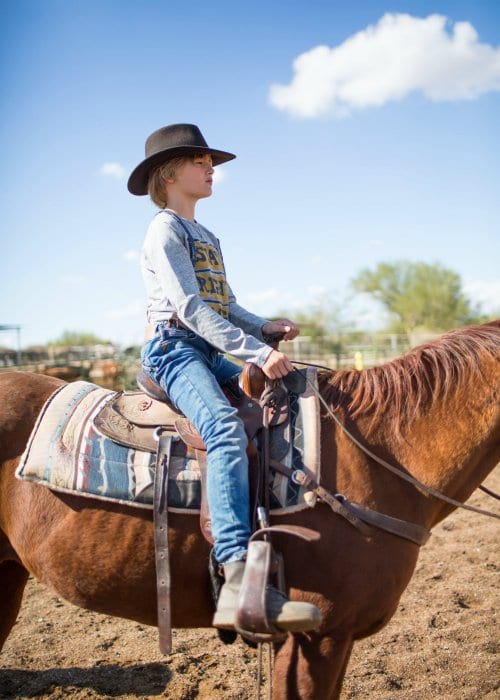
Gearing up for a ride
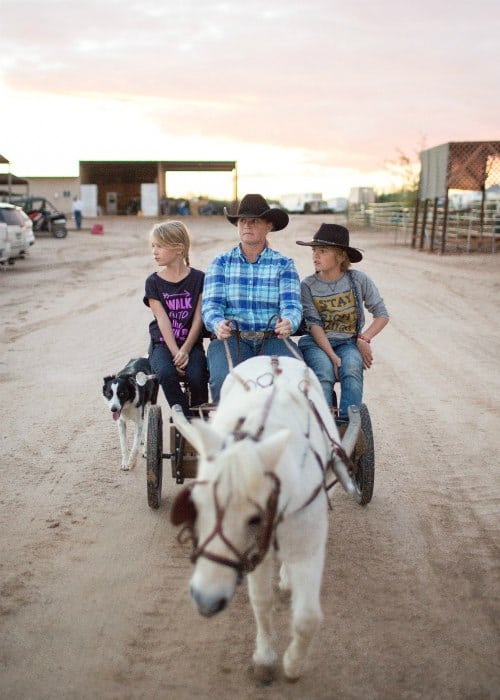
Elaine takes the kids on a sunset buggy ride
The owner, Lori, left us in the capable hands of Elaine, a commanding, almost military, but hilariously dry wrangler. We were won over from the start when she stood in a small fenced ring with an agitated mare and demonstrated how to read horses and speak their language. She was able to make it canter around in a small circle, stop on a dime and walk right up to her while barely moving or speaking a word.
This woman was a real-life horse whisperer. And it didn’t stop there. She could talk to pigs, too, which had the kids in raptures. We were in awe, in love and slightly terrified of Elaine all at the same time – surely, the sign of an excellent teacher. It was hands-on from start to finish, and the kids loved the autonomy. After a quick play on a mountain of hay bales, they were put to work. They cleaned their own horses’ hooves with metal picks; brushed them; put on their saddles; and led them on a lead rein to the arena.
It was here that we rode ourselves into the ground. These horses weren’t on autopilot, but were trained to do exactly as we told them. If we weren’t holding the reins in the right direction, we’d know about it. We trotted and lopped (cantered) until our bums were sore.
Then the final test, guiding our mounts around a tight obstacle course while Lori and the friendly neighbours encouraged us from the sidelines. By the time Elaine had finished with us, we’d picked up more in one afternoon than we’d learned in the previous week. We’d worked hard, and the payback for our efforts was an invitation from the neighbours to take a desert spin in their Mad Max-esque dune buggy while Elaine set up the miniature horse and cart for a sunset ride.
The kids painted a horseshoe as a memento of their graduation from college, before we dined on homemade lasagne, baked outside in a Dutch oven. These lovely people were the embodiment of Southern Hospitality, and we were genuinely sad to say goodbye. We spent our last day soaking up the desert sun by the pool, and that evening, drove to the small town of Cave Creek to eat ribs and watch a rodeo. The venue was open air, ramshackle and buzzing.
At 9pm, babies were still happily eating sand under benches while their parents socialised. Toddlers played around fire pits, and kids no older than five rode sheep in a floodlit rodeo pen for light interval entertainment. If this sounds like negligent parenting, it wasn’t – it’s simply the way of real cowboys: rather than wrap them in cotton wool, they encourage their offspring to toughen up at a young age. These were happy, liberated, respectful kids, and I envied their lack of bureaucracy, and simple family pleasures.
Be warned: cowboy culture is highly infectious. In a short while, it felt like our hats and boots had become part of us. Not only had we learned to ride like cattlemen; we’d learned to let their freedom of spirit into our hearts. It’s not often you return from a holiday with such a priceless gift. One afternoon, during a trail ride, I asked Ellis if he was having a good time. Uncharacteristically, he replied, ‘All I can say is, it’s like a dream come true.’ As family holidays go, I have to agree with him.
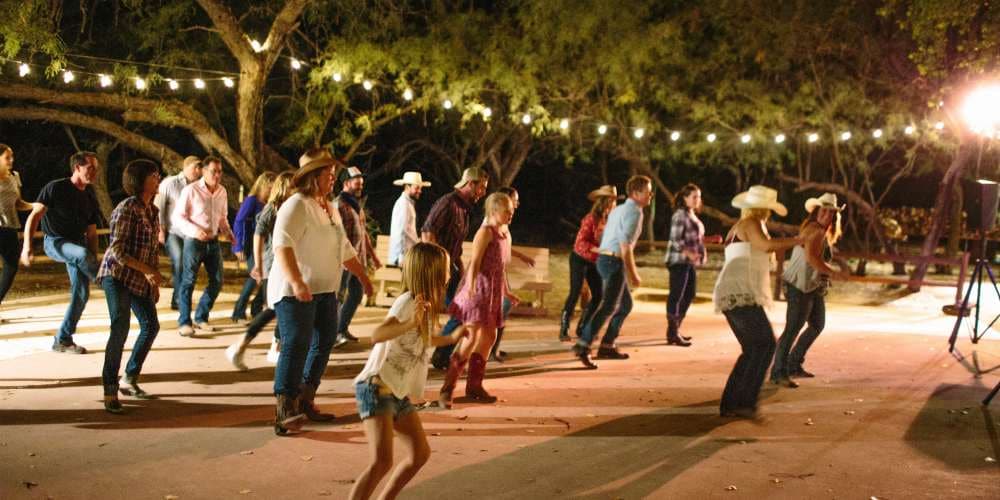
Slip on your boots for a night of square dancing under the Arizona stars
A seven-night fly-drive to Arizona – including return flights on British Airways from Heathrow to Phoenix, seven days’ car hire, three nights at the JW Marriott Camelback Inn, four nights room-only at Tanque Verde Ranch, and one day’s activity at the Arizona Cowboy College – costs from £4,585 for a family of two adults and one child (2-11 years) and from £5,410 for a family of two adults and two children (2-11 years).
Where to visit: Arizona-Sonora Desert Museum Adults £14, children (3-12) £5.50 (under-threes free) desertmuseum.org Buffalo Chip Saloon (steakhouse and rodeo) Scottsdale’s Museum of the West Adults £9, children £5.50 (under-fives free)
Where to eat: Cowboy Ciao, Scottsdale Bryan’s Black Mountain Barbeque, Cave Creek